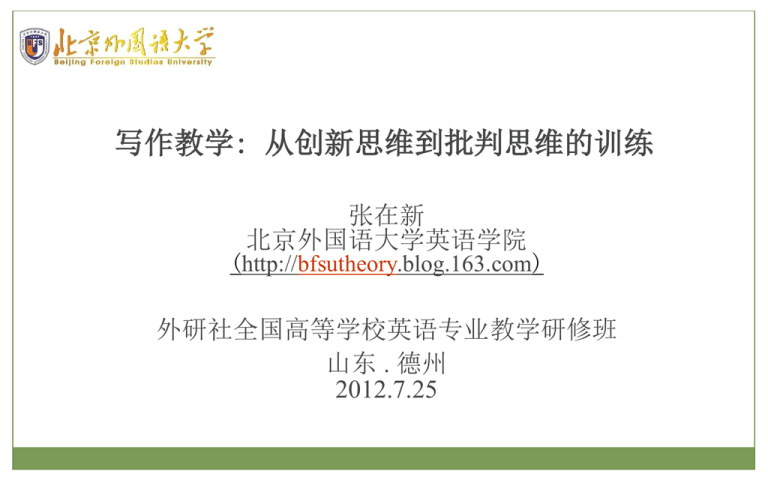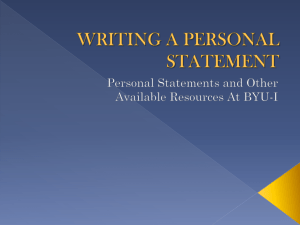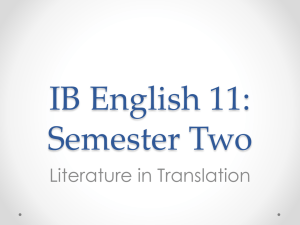
写作教学: 从创新思维到批判思维的训练
张在新
北京外国语大学英语学院
(http://bfsutheory.blog.163.com)
外研社全国高等学校英语专业教学研修班
山东 . 德州
2012.7.25
要点
1. 教育目标分类(认知)在写作教学中的体现
《英语写作教程:从创新思维到批判思维》
第一册《创新思维与写前技巧》helloingyou
第二册《细节描写与读者意识》 roomroom
第三册《中心思想与扩展形式》
第四册《批判思维与议论文》 youknowwhat
2. 创新思维(写作第一册)
创新思维与批判思维的差别
创新思维的特点
创新思维策略、练习
2
要点
3. 批判思维
批判思维的定义
思维能力的一般标准
(Elder and Paul, “Universal Intellectual Standards”)
写作第二、三册中的批判思维训练
(清晰、关联、深度、意义)
写作第四册中的批判思维训练(逻辑)
3
1. Taxonomy of Educational Objectives
Bloom (1956) and Anderson (1999)
Remember recalling and recognizing specific information,
concepts and ideas in the form in which they are learnt
[Narrative/past experience essay, 第二册]
Understand grasping the meaning of material, including
interpreting, exemplifying, classifying, summarizing, inferring,
comparing and explaining [summarizing, 第一册]
[classification, comparison/contrast, etc. 第三册]
Apply carrying out or using a procedure in a given situation or
transferring selected information to a new task
[How-to process essay, 第二册]
4
Taxonomy of Educational Objectives
Analyze breaking material into constituent parts and
determining how parts relate to one another and to an overall
structure or purpose, including differentiating, organizing
and attributing [Problem/solution essay, 第三册]
Evaluate making judgments based on criteria and
standards, involving appraisal, checking and critiquing
[Evaluation essay, 第三册;argumentative essay, 第四册]
Create putting elements together to form a coherent or
functional whole; reorganizing elements into a new pattern
or structure, involving generating, planning and producing.
[Creative thinking and prewriting, 第一册]
5
第一册《创新思维与写前技巧》
2. Creative Thinking
Being generative
“Judgment is suspended during the generative stage
of thinking in order to be applied during the
selective stage.” (Creative vs. Critical)
Being effective
“Being right means being right all the time. Being
effective means being right only at the end”
(De Bono 1970). (Creative vs. Critical)
6
第一册《创新思维与写前技巧》
Creativity is the ability to suspend judgment,
discover new links between familiar things, look
at problems or issues from new perspectives, and
form new combinations from concepts already in
the mind. It is the ability to think outside the box.
Creativity is “a blend of unusual and good or useful
ideas” (Halpern 1984).
Creative thinking is a way of thinking that makes
all this happen – to train students for the creative
ability.
7
第一册《创新思维与写前技巧》
Characteristics of Creative Thinking
1. Fluency(流畅性), Flexibility(灵活性)
Originality(独特性)
Fluency is your ability to produce a large number
of ideas in a given length of time, while flexibility
refers to your ability to generate a wide variety of
ideas (Adams 1996). In other words, for fluency in
creative thinking, you go for quantity, and for
flexibility, you aim at the diversity of the ideas
generated.
8
第一册《创新思维与写前技巧》
Fluency, Flexibility, and Originality
Originality “is the ability to produce
unusual ideas, solve problems in unusual
ways, or use things or situations in an
unusual manner. Creative individuals
produce uncommon responses, make remote
associations, and produce clever responses”
(Evans 1991).
9
第一册《创新思维与写前技巧》
Characteristics of Creative Thinking
2. A Questioning Attitude
“A creative person should have a healthy
skepticism about existing answers, techniques,
and approaches” (Adams 2001).
10
第一册《创新思维与写前技巧》
Creative Thinking Exercise
Assignment: Creative Strategy Report
Fluency, Flexibility, and Originality
11
第一册《创新思维与写前技巧》
Creative Strategies (10 of them in the book)
Random Word Stimulation (任意词激发)
Creative thinkers would like to be exposed to
“irrelevant input” to spark something they didn’t
think possible before. “In the random word method,
one very deliberately generates a random stimulus”
(De Bono 1971).
12
第一册《创新思维与写前技巧》
Creative Thinking Exercise
Assignment: Open-Ended Story
Group Work: Pick one of the two open-ended
commercials supplied by the instructor and complete the
following three tasks in groups of three: (1) describe the
story in the commercial, (2) propose three of the best
endings you can figure out for the story, and (3) comment
on the creative strategy/strategies used. Be creative, and
keep in mind all the creative strategies we have covered so
far as you think about the possible endings.
Corrupt Warden
13
3. Critical Thinking
“Critical thinking is intelligent reasoning with
supporting evidence to help make wise decisions.”
Critical thinking is “an understanding of the
relationship of language to logic, leading to the
ability to analyze, criticize and advocate ideas, to
reason inductively and deductively and to reach
factual or judgment conclusions based on sound
inferences drawn from unambiguous statements of
knowledge or belief” (Caputo 1994).
14
“Universal Intellectual Standards”
Linda Elder and Richard Paul
1. Clarity (清晰): Could you elaborate further on
that point? Could you express that point in another
way? Could you give me an illustration? Could
you give me an example?
2. Accuracy (准确): Is that really true? How
could we check that? How could we find out if that
is true?
3. Precision (精确): Could you give more details?
Could you be more specific?
15
4. Relevance (关联): How is that connected to the
question? How does that bear on the issue?
5. Depth (深度): How does your answer address the
complexities in the question? How are you taking into
account the problems in the question? Is that dealing
with the most significant factors?
6. Breadth (广度): Do we need to consider another
point of view? Is there another way to look at this
question? What would this look like from a
conservative standpoint? What would this look like
from the point of view of...?
16
7. Logic (逻辑): Does this really make sense? Does that
follow from what you said? How does that follow? But
before you implied this and now you are saying that;
how can both be true?
8. Significance (意义): Is this the most important
problem to consider? Is this the central idea to focus on?
Which of these facts are most important?
9. Fairness (公平): Do I have any vested interest in
this issue? Am I sympathetically representing the
viewpoints of others?
17
第二册《细节描写与读者意识》
Critical Thinking
Clarity: Show more than tell
Group activity (in groups of four): In about ten
minutes, write with concrete details to make the
following general statement more specific. Select a
spokesperson to report your writing to the rest of
the class. (Write a SES)
Telling: Elaine is clever.
18
第二册《细节描写与读者意识》
Critical Thinking
Relevance: Audience
Coca Cola, LV (Louis Vuitton) commercials
19
第三册《中心思想与扩展形式》
Critical Thinking
Depth (深度): How does your answer address the
complexities in the question?
Significance (意义): Is this the most important problem
to consider?
Problem/solution essay: feasibility study
作文“宿舍鼠害问题”可行性分析的样题:运用
批判思维的“深度”和“意义”标准去考虑解决问
题方案的复杂性,并从初选出来的方案中确定最重
要、也是最切实可行的方案作为文章扩展的内容。
20
第四册《批判思维与议论文》
Critical Thinking
Logos, ethos, pathos, needs
逻辑、可信度、情感、需求
21
Needs Analysis (需求分析)
Abraham Maslow’s Hierarchy of Needs
Biological and Physiological needs - air, food, drink, shelter,
warmth, sex, sleep, health, etc.
Safety needs - security, order, law, stability, etc.
Belongingness and Love needs - work group, family, affection,
relationships, etc.
Esteem needs - self-esteem, achievement, mastery, independence,
status, prestige, managerial responsibility, etc.
Self-Actualization needs - realizing personal potential, selffulfillment, seeking personal growth and peak experiences.
22
第四册《批判思维与议论文》
Needs Analysis
Healthy Back Bag, Ideal for Men or Women...
Business or Travel. This attractive leather bag is
designed to reduce weight stress on neck,
shoulder and back by 30%.
Analysis: The ad addresses consumers’ needs for
health. It may be true that weight stress can be
reduced by 30% if the shoulder strap becomes
30% wider than before.
23
第四册《批判思维与议论文》
Needs Analysis
A Sparkling Water Commercial (Perrier)
[Romantic music playing in a bar] A woman
puts two glasses on the bar and reaches for a
small bottle of Perrier. She keeps caressing the
bottle, and it swells and gets bigger and bigger
till it becomes a huge thing standing erect on
the counter top. As the sparkling water inside is
24
第四册《批判思维与议论文》
Needs Analysis
churning, the bottle cap turns by itself slowly.
The woman’s slender fingers are sliding up
and down the bottle as if to encourage the
excited Perrier to gather more momentum.
Suddenly the agitated liquid ejects the bottle
cap and erupts from the bottle.
25
第四册《批判思维与议论文》
Fallacies (逻辑错误)
Appeal to Emotion (情感诉求)
Appeal to compassion, pity, or guilt: a rhetorical ploy
attempting to move us to do something purely by
evoking a feeling of compassion towards the recipients
of the suggested act or belief, or a feeling of guilt about
their plight.
Examples
1.
“But you can’t fire me, Mr. Watts. I’m the only one who
knows how to repair the machine. Besides, I have seven
mouths to feed!” (Good)
26
第四册《批判思维与议论文》
Fallacies
2.
Give her a chance, Walter. She’s a good person,
and she’s had a really hard time since her
mother died. She’s never worked in an office
before, but you’ll be giving her the first break
she’s had in a long time.
3.
I’d really like a chance to take the midterm
again, Professor Zhang. My GPA is in bad shape
and I’m already failing one of my other classes.
27
第四册《批判思维与议论文》
Fallacies
Appeal to cuteness: argument by personal
charm; a fallacious rhetorical technique to
urge us to buy a product or take an action via
its association with the cute figure delivering
the message (similar appeals: to sexiness,
vanity, wealth, status, power, coolness, etc.).
28
第四册《批判思维与议论文》
Fallacies
Appeal to fear: also known as scare tactics: a
tactic of trying to elicit a fear in one’s readers or
listeners in order to influence their behavior or
attitudes.
Example: A boy is looking at a football inside a
compound, where high-voltage power lines
crisscross pylons. The compound is surrounded
by a tall iron mesh fence, on which hangs a sign
that reads
29
第四册《批判思维与议论文》
“Warning! Danger! Unauthorized Persons
Prohibited Beyond This Point.”
But the boy cannot read, so in spite of the
warning, he climbs up the fence, trying to climb
over it to get the ball on the other side of the
fence.
“Illiteracy is Dangerous. Empower a Child to
Read.”
30
第四册《批判思维与议论文》
Illiteracy Advertisement
3. A man is driving a car, but the road signs
he sees are all blank to him. He stops at the
traffic island by the access road to a freeway.
31
第四册《批判思维与议论文》
False dilemma (极端选择): also known as the either/or
fallacy or the black-or-white fallacy: erroneous
reduction of alternatives or possibilities, usually a
reduction to just two.
Either we raise taxes by 10% or we drown
ourselves in a budget deficit.
Analysis: We are given only two options here.
How about other alternatives? Like cutting down
on government spending, or a 5% tax increase,
not 10%.
32
第四册《批判思维与议论文》
Appeal to novelty (标榜新潮): attempting to
persuade us to try or buy something because the
item is new and, by implication, different from
and better than existing related items.
Appeal to tradition (崇拜传统): also known as “Old
ways are best”: appealing to the past as an
authority; this fallacy occurs when it is assumed
that something is better or correct simply because
it is older, traditional.
33
第四册《批判思维与议论文》
Examples
1. Off the Wall
Voiceover: “Today’s best commercials are often full of
surprises. And some are literally ‘off the wall.’”
A man is admiring a car on display on a wall in an
exhibition room of an art museum. With the door open
on the driver’s side, the man gets into the car [made
possible by creative photography] and drives the car “off
the wall,” literally, leaving behind a trail of tire marks on
the wall. An old lady, who is browsing in the exhibition
room, comes to the tire marks and looks at them.
34
第四册《批判思维与议论文》
Off the Wall
“The New Accord.” [With the HONDA logo]
The old lady—perhaps she’s thinking aloud “They
call this art?”—is checking the museum guide for
information about the “art work” in front of her.
Analysis: The new Accord is not necessarily a better
model, unless the commercial specifies the
improvements of the new model over the previous
one.
35
第四册《批判思维与议论文》
2. Wheat Fields
A middle-aged farmer is scything wheat in
the fields. He takes a break and drinks some
water, when a group of horsemen in armor are
coming from a distance and soon riding past
him, shouting a war cry. All of a sudden, a
fighter plane whizzes by overhead, and an eagle
is soaring in the blue sky. Then a cavalry
regiment
36
第四册《批判思维与议论文》
emerges in the wheat fields; horses are neighing
and weapons clanking as the cavalrymen run
past the farmer. He calmly takes out a whetstone,
sharpens his scythe, puts the stone back into its
pouch, and goes on with his work.
“Barilla. Il lavoro continua. Dal 1877.”
[Barilla has been working for you since 1877.]
37
第四册《批判思维与议论文》
Faulty Analogy (错误类比)
Illustrative analogies help readers see more
clearly what the writer tries to explain, where a
complex or abstract concept is involved.
A faulty analogy, however, is one that compares
two things known to be alike in one or more
features and suggests that they will be alike in
other features as well.
38
第四册《批判思维与议论文》
Examples
Illustrative: Trying to define true love is like trying
to nail Jell-O to a tree.
Faulty: “I Don’t Spit in Your Face—Please Don’t
Blow Smoke in Mine.”
Analysis:
This is a faulty analogy. Although spitting and
blowing smoke in one’s face are similar—both acts are
rude, the two are dissimilar in other features: the
first is much more offensive than the second.
39
第四册《批判思维与议论文》
Dental Floss (illustrative)
Butts (Faulty)
Host: As we’ve seen, public service
announcements have changed a bit since the day
they were stuffy and self important. Even
serious messages can be delivered in a funny
way. Take a look at these seriously funny spots.
40
第四册《批判思维与议论文》
[Showing various animals’ butts …]
Host: Pay attention, this one’s got a surprise
ending.
Advertisement on the screen: “Of all the butts in
the world, this is the grossest.” [Showing a
cigarette butt]
Minnesota Department of Health
41
第四册《批判思维与议论文》
Equivocation (含混不清): a ploy that
deliberately exploits the ambiguity of a word
or phrase in the given context, to influence
our actions or beliefs by misleading us.
Man is a rational animal.
Woman is not man.
?Therefore, woman is not a rational
animal.
42
第四册《批判思维与议论文》
Example
Sale at IKEA
A woman checks out at a cash register, takes her
receipt, and thanks the cashier. The customer looks
at the receipt with a surprise expression on her face,
thinking she’s been undercharged. Running out of
the store, carrying two shopping bags full of
merchandise, she shouts to her husband waiting in
the car: “Start the car! Start the car! ...”
43
第四册《批判思维与议论文》
(Advertisement on the screen: “It’s not a mistake.
We’re having a sale.”)
Without knowing what’s happening, the husband
puts down his newspaper and does what he is told.
The woman is sitting in the passenger seat of the
car, shouting and cheering triumphantly.
Voiceover: “The IKEA Summer Sale. Up to 50%
off (selected items). IKEA Fits.”
44
第四册《批判思维与议论文》
Analysis:
With “up to 50% off,” there can be a sale
Anywhere between a pitiful 5% off to 50% off—a big
Difference between the two, but the commercial may
attract easy-to-believe customers to come to the store
to hunt for 50%-off price tags on merchandise, only to
find selected items marked down 10% or even 5%,
not 50%. When asked where you can find those best
buys, any shop assistant could tell you “Sorry, we’re
sold out.”
45
第四册《批判思维与议论文》
The best part (for them) is that the commercial did
not lie about it. They did say “up to 50% off” in the
commercial. But we don’t have to fall for this
ambiguity. Finally, what exactly does the slogan
“IKEA Fits” mean? In what way does it fit? It fits for
doing what? It’s an incomplete claim, without a
definite meaning. Whatever positive thing you could
think of, it would be your own problem if it didn’t live
up to your expectations, because the commercial did
not promise anything specific.
46







